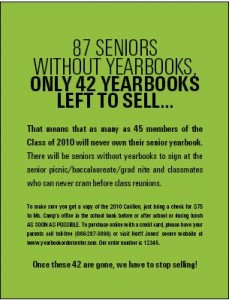SELLING OUT
TIPS TO DO IT QUICKLY
If you’ve finished your book and are counting the weeks until delivery day, there’s one remaining task that’s more important than all others. True, this post-production time often begins the cycle anew as staffs recruit, interview for editors, announce staff positions for the next year and start theme brainstorms. But even more important than building those foundations for the future is ensuring your financial well-being this year.
If you are not sold out yet, collecting money for your current yearbook is the most important thing you can do in coming weeks. There’s nothing like a few disappointed seniors to encourage earlier sales in years to come. If your readers know there will still be books available at distribution time, they have little incentive to purchase in advance.
Even though many staffs tier their pricing with the best price at the start of the school year, it’s all too common that the difference between the starting price and the cost on distribution day is not significant enough to warrant a second thought. And last fall’s prices don’t really matter any more; what matters is that you need to erase all financial doubt by creating a sense of urgency and selling as many books as possible as soon as possible.
First, let’s define selling out. You’ve placed an order for a certain number of yearbooks and (hopefully) you planned in advance to make sure that even if you sold all of your books at the lowest price, you’d still break even. Each year, you need to determine how many of the books you’re ordering won’t be sold. Those should both be subtracted before you set prices and be separated physically from the other books once they arrive.
It’s important to have some archival copies of the yearbook on campus. In some cases, the only complete set is in the yearbook room, but many times the library, the alumni office and key administrators will have copies as well. These people probably have media budgets, so it’s a fair expectation that they, like your student buyers, would pay for their yearbooks.
And the yearbook program probably accounts for some books that will not be sold. You may have a certain number of yearbooks you need for contests, critiques and exchanges. Like the others, you need to plan for the expense of these books knowing that you’ll never receive income for them and you need to set them aside so that when it’s contest time, you have a book to submit. It’s also not a bad idea to hold back 5-10 books until you know more about your overrun situation. If there are damaged books, you want to be able to replace them and keep your readers, their parents and the school happy.
It’s time to do some math. Start with the number of books you ordered and subtract the number of books you don’t plan to sell. (This will be a total of any comped books, archival copies, contest/critique/exchange copies and books held back to replace damaged volumes.) From that, deduct the total number of books sold in all previous sales campaigns. The remaining number is the count of books you have left to sell as quickly as possible. Some people hold out an additional 10 books to make sure they have some to sell at their distribution day price and to create an even greater sense of desire for the book. If you don’t have a history that lets you know how many books you can expect to sell at the end, or if you have really pushed harder than ever this year to sell books, you might feel more comfortable holding back five books to sell at your top price. Remember to treat your books as cash, though; if any of those books goes unsold, you’re leaving cash on the table.
The earlier you can announce that you’re sold out, the better off you will be for this year and in the future. Right now, you merely want that date to be as soon as possible. Training the students that they can’t wait until after the books arrive on campus to purchase their copy will benefit you and your staff in several ways.
Beside the fact that it will alleviate your financial worries, news of a sell-out will raise awareness of the yearbook and create more anticipation for the book’s arrival on campus. You’ve worked hard to create a book that captures the year as it was for the whole school and knowing that the masses are excited to see your work will feel great.
Let’s get started with some selling ideas:
As you begin this process, it’s crucial that your sales lists are accurate and up-to-date. Consider sorting the non-buyers by grade to determine how many seniors (or eighth graders if you are a middle school) have not purchased yearbooks. You might find that you don’t even have enough for all of that class to get one. If that’s the case, a postcard might be all it takes to sell out in a matter of days.
 A message like “66 seniors without yearbooks, 27 yearbooks left to sell. Not everyone who wants one will have the chance to own one.” If you have lots left to sell, you might also check the youngest class. You could divide the number of remaining books down so that your senior cards would say there were 77 left for seniors and another set would list 78 books left for freshmen instead of saying that there were 155 books left.
A message like “66 seniors without yearbooks, 27 yearbooks left to sell. Not everyone who wants one will have the chance to own one.” If you have lots left to sell, you might also check the youngest class. You could divide the number of remaining books down so that your senior cards would say there were 77 left for seniors and another set would list 78 books left for freshmen instead of saying that there were 155 books left.
A sales thermometer in a very public location showing a rapidly decreasing number of books does a lot to promote your cause. If you create this, you’ll want to make sure to update it at least daily. If the week starts with a thermometer showing 24 books left to sell and there’s no change by Thursday, you’re sending an entirely different message than 24 books left to sell decreasing to 19 by noon, 16 after school and 11 the following morning. It’s up to the yearbook staff to create the sense of urgency to buy.
Another kind of targeted postcard might alert non-buyers that they’ve appeared on certain pages in the book. When students are asked why they haven’t purchased a yearbook, one common answer is that they don’t think they will be included in it. If you run HJ Index Builder on your entire book, you will have easy access to the page numbers on which each student appears. Take advantage of the free merchandising materials from Herff Jones, including the “You’ve Been Tagged” postcard. Your yearbook kit will contain samples of the next year’s merchandising campaign.
The staff at George Washington HS in Danville, VA has done a large-scale twist on the postcards for years. Instead of sending postcards to individual students, they create posters on the colorful butcher paper from the activities office. The message is the same: “Hey, _________________, you’re on pages x, xxx and xxx and you didn’t buy a yearbook yet” the poster might say. They create a number of the 3 x 6’ posters to hang around campus and post an index near the yearbook office. Then anyone can see how many times they are in the book. The posters merely remind the school that it’s time to think yearbook again.
And Dunnellon (FL) HS’s staff ran Index Builder to determine who’d been in the book three times and then created a Wordle of the names that they posted to their Facebook page and hung around campus. The graphic interpretation was a different way to remind students who were in the book that they had yet to buy. A few days later, the poster was a heavily leaded listing of all non-buying students who appeared in the book repeatedly with a reminder that their sell-out was imminent.
Do what you can to make sure you sell out as quickly as possible. Then you’ll need to decide how to handle the buyers who still want books. Will you start a waiting list for potential overruns? Do they have to bring cash for the full amount to hold a place on that list? Will you be doing a lottery for remaining books?
If you have created a situation where you can announce for weeks that the yearbook, which is arriving mid-month, is already sold out, you will definitely receive phone calls and visits from people who expected to be able to buy at distribution.
Prepare yourself by creating a list of all the opportunities they already had to buy and make sure that you provide everyone who still “needs” a book the same information about the procedure for possibly getting a book during distribution.
Then enjoy a couple of less stressful weeks, start planning for next year’s masterpiece and prepare for the distribution of the yearbook so loved by the school that it sold out before it even arrived on campus. And that will be good for next year’s program as well!



